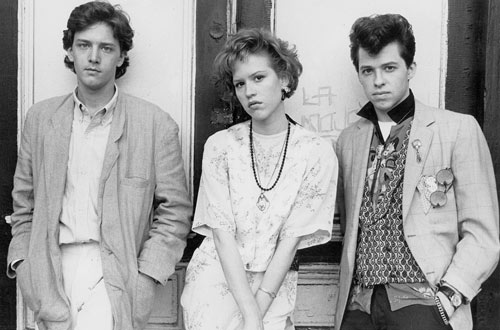Pretty in Pink (1986)

The 1980s were full of “wrong side of the tracks” romances, from Valley Girl to Say Anything, and in Pretty in Pink, screenwriter John Hughes (Ferris Bueller’s Day Off, Mr. Mom) tells the story from the perspective of a lower-class young girl fancied by a “Richie,” one of her school’s many well-to-do young men. Coming out a year after Hughes’ Breakfast Club, he continued to keep his finger on the pulse of teens of the times, not seeing them merely as vessels for fun and games, showcasing the difficulties of growing up in the “Me Generation,” where status and upward mobility were the criteria by which you were judged. He also recognizes the awkwardness of being a teenager, which is a sort of universal feeling that very few films aimed at pre-adults manage to tap into in any meaningful way. Pretty in Pink does, and though it doesn’t break enough away from the formula to become something truly extraordinary, it is refreshingly astute about its characters, and talks directly to its audience rather than down at them.
Molly Ringwald (Spacehunter, Face the Music) shows off her best acting chops in this film, perfectly encapsulating the often clumsy and easily embarrassed mannerisms of a girl who perpetually feels like a fish out of water among her snooty peers. She plays Andie Walsh, a high school senior who doesn’t seem to fit in with anyone else at her school, save perhaps for her equally odd friend Duckie (Cryer, Superman IV), who has been carrying a torch for her in a way he can’t help but constantly tell her about. When she meets Blane (McCarthy, Mannequin), they both find themselves instantly smitten with each other. However, Andie is seen as white trash among her school’s more affluent peers, and though Blane doesn’t care about such things initially, eventually the pressure among his peers to not see someone who is “nothing” makes him begin to question whether he can lose friends and upset his family by pursuing her.
Although often billed as a comedy, primarily due to the film’s high-energy Duckie character, perfectly embodied by Jon Cryer’s memorable performance, the bulk of Pretty in Pink resides in the teen romance and drama genres. This is really about the angst of first loves, and the difficulties that follow when a boy and girl want to be with each other so badly, they can think of nothing but. The drama occurs when Blane begins to crack under the immense pressure of finding himself in disfavor among his friends, mostly exemplified by his prick best friend, Steff (Spader, Sex Lies and Videotape). Unbeknownst to Blane, Steff’s real reason to dislike his burgeoning relationship with Andie is due to the fact that he’s also attracted to her.
Perhaps this kind of sticky romance will be easy for most adults to guess what’s going to happen long before they occur, as it does follow a familiar formula that had been well established long before its introduction into theaters in 1986. However, the target audience, mostly teenage girls, have rarely seen a film aimed at them with this amount of depth and nuance, speaking directly to actual feelings and situations they may have been experiencing themselves at the very time they first see it.
The ending, which was famously changed from Hughes original script to give everyone a much more hopeful outcome, is like that cherry in an ice cream sundae — sweet, but largely unnecessary for one’s overall enjoyment. The other ending tried for a bit of realism and realization of the limitations of one’s birth and niche in life. though not many, including those working on the film, thought that she could ever truly find happiness and love with someone she viewed as a brother more than a lover. Hughes would revisit this ending for a future 1980s project, Some Kind of Wonderful.
Thanks to some very good casting (though Spader, in his mid-20s, looks far too old to be playing high school age), solid performances, and the insights of John Hughes at the peak of his creative screenwriting talent, Pretty in Pink emerged as an instant teen classic, and remains, to this day, a quintessential film for those who enjoy everything 1980s.
Qwipster’s rating: A
MPAA Rated: PG-13 for language and brief drug use
Running time: 96 min.
Cast: Molly Ringwald, Jon Cryer, Andrew McCarthy, James Spader, Harry Dean Stanton, Annie Potts, Kate Vernon
Cameo: Andrew Dice Clay, Gina Gershon, Dweezil Zappa, Kristy Swanson
Director: Howard Deutch
Screenplay: John Hughes
